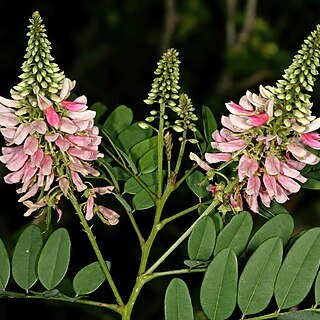Robust, scrambling to erect shrubs or small trees (0.8-)1.5-3(-7) m tall. Stems greyish brown, up to 15 cm in diameter, laxly to densely many-branched; brachyblasts often present; branches angular, pale cream or yellowish, striate or fissured, scattered with minute, dark red pearl bodies; glabrous or sparsely strigillose to hispidulous on juvenile growth, hairs ± equally biramous, the tips often spreading, white and brown hairs mixed. Leaves alternate, pinnately (7-)9-15-foliolate; leaf axis channelled above, (3-)4-10(14) cm long, including a petiole of (6-)10-20(-24) mm and extended (2-)3-8 mm beyond the lateral leaflets. Stipules (2-)3-4 mm long, ± erect, subulate, lanceolate or triangular-ovate, often falcate, fused below the base of the pulvinus and separated from the latter by a commissure, apex acute to acuminate. Leaflets sub-opposite or opposite, entire; stipels 1-1.5 mm long, subulate-setaceous; terminal leaflet (7-)14-25(-30) X (3-)6-15(-20) mm, obovate or oblong-elliptic; apex emarginate, truncate or rounded, base cuneate, sometimes attenuate, the laterals often longer, more narrowly elliptic to oblong; upper surface dark green, glabrous or minutely strigillose, hairs ±45° to the midrib; lower surface more densely strigillose, distinctly paler than above. Racemes 5-10(-20) cm long, more or less equalling to about twice the length of the subtending leaf, including a peduncle of 9-45 mm, densely sub-spicate (at least when young), ±20-50-flowered. Bracts (0.5-)1-2.8 mm long, not exceeding the buds, subulate, early caducous; bracteoles absent. Pedicels (2.5-)4-7(-9) mm long, strigillose, spreading. Flowers 7-9 mm long with explosive pollen release, the lower petals (at least) soon caducous. Calyx 12 mm long, very open, shortly and bluntly 5-lobed, sparsely to densely minute strigillose, hairs white and brown, lobes triangular, about a third the length of the tube, vexillary lobes separated by a broad sinus. Corolla sweetly scented, pink and white. Standard (5-)6-7.5 mm long, more persistent than the other petals, often folded over the stamens, broadly elliptic to sub-orbicular, tapering ± abruptly to a short claw at the base, apex rounded or obtuse, minutely apiculate, appendages absent, dorsal surface densely white puberulent, sometimes with isolated coarse brown hairs along the midrib or margins, lamina cream or pale pink, central blotch paler than the rest, apparent as 2 distinct regions on either side of the midline, green to white becoming somewhat speckled during post pollination colour changes, glabrous or sparsely hairy, distinctly surrounded by a darker pink areola. Wings shorter than to more or less equalling the keel petals, ±8 mm long, forming a platform above the keel, lamina bright pink with rugose proximal crests scattered with isolated hairs, inner and outer margins tapering to a distinct acute or rounded apex, margins ciliate. Keel petals 7-8 mm long, not exposed between the wings, valvately connate distally, lamina with a dense fringe of short white or pinkish hairs along the region of curvature of the upper margin, lateral spurs 1-2 mm long, robust, broad to attenuate; distal margin curving upwards from the base of the keel to a ± obtuse apex, claws ±2 mm long, broadening from the base, lamina white or green becoming pale pink above, moderately to densely minute white puberulent particularly at the apex and along the distal and lower margins. Stamens (4.5-)5.0-6.5 mm long, alternately long and short, the 9 fused filaments free for ±1 mm distally; anthers uniform, ±1 mm long tapering to an apical expanded connective, hairs sometimes present at the apex and/or base; intrastaminal nectariferous disc present. Ovary at least two thirds the length of the pistil, essentially glabrous; style curving erect ± directly from the ovary; stigma capitate, penicillate. Infructescence usually lax. Pods (25-)30-50 mm long; 3-4 mm wide, cylindrical, straight, glabrous, reddish-brown, usually ascending or patent, 2-valved with broad transverse papery septa between seeds, explosively dehiscent with valves twisting, persistent basal cup remaining in the calyx after valve dehiscence endocarp spotted with tannin deposits. Seeds 5-8, 2-3 x 2-2.5 mm wide-ellipsoid to sub-globose; brown to dark brown, not mottled; hilum central to sub-terminal.
More
Robust shrub or small tree, (0.8)1.5-3.0(7.0) m high; stems greyish brown, pale cream-coloured or yellowish, scattered with dark red pearl bodies. Stipules (2)3-4 mm long, lanceolate. Leaves pinnately (7)9-15-foliolate, rachis (30)40-100(140) mm long; petioles (6)10-20(24) mm long. Terminal leaflet (7)14-25(30) x (3)6-15(20) mm, obovate to oblong-elliptic, base cuneate, apex emarginate, rounded, both surfaces strigillose, the lower more densely so, discolorous, paler. Inflorescences of 50-100(200) mm long, ± densely 20-50-flowered racemes; peduncle 9-45 mm long; pedicels (2.5)4.0-7.0(9.0) mm long. Flowers 7-9 mm long, pink and white; calyx 1-2 mm long, open, 5-lobed, strigillose, lobes triangular, up to 1/3 of tube length; standard dorsal surface densely white puberulent, keel apex obtuse. Stamens (4.5)5.0-6.5 mm long. Flowering time July-Apr. Pod (25)30-50 x 3-4 mm.

